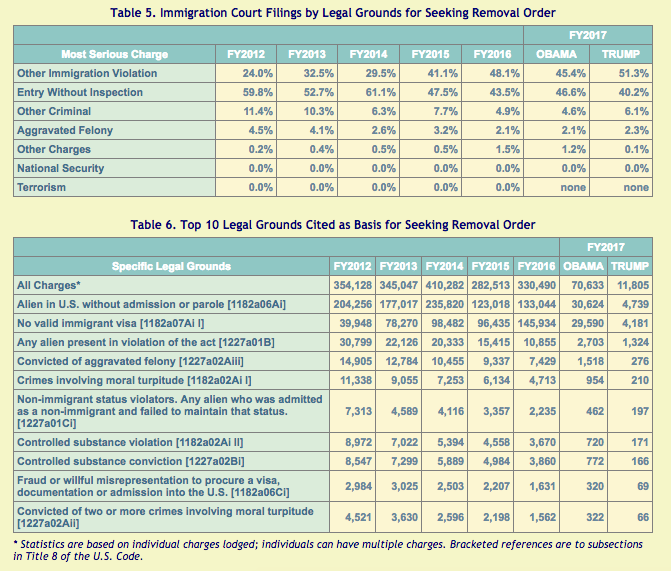We got this discovery from Latino Rebels contributor Matthew Kolken, who shared the news of the first report about immigration cases during the Trump administration from Syracuse’s TRAC Immigration. Here is the direct quote from the report (boldface text is our emphasis):
Legal Grounds Cited for Seeking Removal Orders
Over nine out of ten post-Trump cases rely on immigration charges as the basis for seeking a removal order. About 40 percent are for illegal entry, while 51 percent were for other immigration charges. The most common of these other types of immigration charges were for no” current valid immigrant visa,” or simply “being present in the country in violation of the law.” In only 2 percent of the cases were persons charged with having an aggravated felony, while an additional 6 percent were charged with participating in other types of criminal behavior. There were no terrorism charges, and just 3 cases where the individual was charged with a “national security violation.”While this pattern is not dissimilar to the pattern of charges observed in Immigration Court cases under President Obama, there has been a shift away from illegal entry as the grounds for seeking deportation and a rise in other immigration offenses, such as not currently having a valid immigrant visa which can occur if the person entered legally and then stayed beyond the period permitted under their visa.
Table 5 provides a year-by-year comparison of the most serious grounds DHS cited for seeking a removal order in Immigration Court, while Table 6 lists the top 10 specific charges in post-Trump cases along with similar numbers for these charges in earlier years.
It is also important to note this introduction from TRAC:
The latest available case-by-case Immigration Court records through the end of February 2017 give an early glimpse at what, if any, changes are emerging in deportation actions by the Department of Homeland Security (DHS). Because so little time has passed since the inauguration of Donald Trump as president on January 20, and given that DHS has broad administrative powers that under many circumstances allow it to bypass the Immigration Court when deporting noncitizens, these court data provide at best a very limited view of immigration enforcement activity around the country.
Court records reveal that so far, since Trump assumed office, a total of 11,040 cases have been initiated by DHS seeking removal orders. This represents the number of DHS Notices to Appear (NTAs), or comparable forms, dated after January 20, 2017 that had been filed in court as of the end of February 2017. NTAs are the official notification to an individual that DHS is seeking to deport them.
Because there is often a delay between the date of the NTA and the date it is filed and recorded by the Immigration Court, around half of the NTAs filed during the post-Trump period still reflect NTAs initiated under President Obama. This report focuses just on those NTA’s that were dated after Trump assumed the presidency and have already been filed and recorded by the court. We refer to these as “post-Trump cases.”
On another note, TRAC also said this:
TRAC will continue to monitor immigration enforcement actions under the Trump Administration as additional data becomes available. We anticipate that we will be able to update these Immigration Court numbers on a monthly basis, as we receive new data from the courts in response to our regular Freedom of Information requests for updates.
Unfortunately, Immigration and Customs Enforcement (ICE) has started withholding other more comprehensive information that ICE previously released to TRAC in response to Freedom of Information Act (FOIA) requests. ICE does not claim the withheld information is exempt from disclosure, it simply claims past releases were discretionary and it is no longer willing to make many of these details available to the public.
Because of these ICE refusals, TRAC is unable to update its online free web query tools that allow the public to view ICE activities under both the previous Bush and Obama Administrations. We are also currently in court on another FOIA action trying to obtain ICE records on what fields of information the agency’s databases actually track. Even though ICE released these descriptive documents before, ICE now refuses to provide updated listings describing its data. Our brief in that litigation was filed March 10.
You can read the entire report here.




